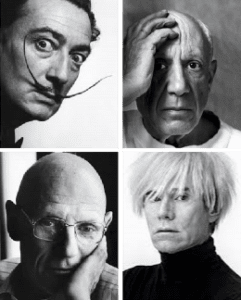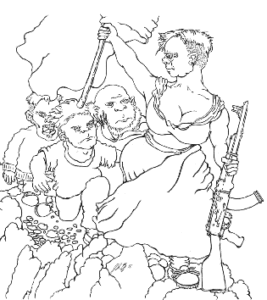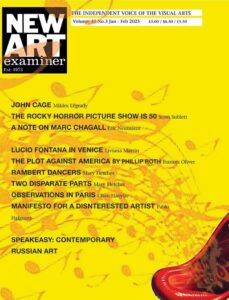
Top: Salvador Dali, Pablo Picasso Bottom: Michel Foucault Andy Warhol
Three Essays on the Limits of Postmodernism after November 2016
Volume 31 no.3 : The Illusion of Progress Why the election results should not have been surprising
Future Issues:
Volume 31 no.4: Blood-drenched Brushes and Golden Easels: An analysis of what Derek Guthrie calls the “Americanization of the avant-garde”
Volume 31 no.5: The Will to Ignorance: The role of academia in the postmodern debacle

A thing can move in any direction.
Whether or not it progresses is strictly a question of perception. Ever since Jean-Jacques Rousseau, the Western understanding of freedom, justice, and equality has struggled between reformist evolution and revolutionary brutality. The problem does not lie with freedom, justice, and equality but with the inability to see and accept the contradictions inherent in humanity. When Hannah Arendt grasped, to her own horror, that most of humanity was capable of being like Adolf Eichmann, her insight offended progressive circles. It still offends. Only Nazis are capable of Eichmann’s crimes, or so we wish to believe. In 1947, Albert Camus had reached, in The Rebel, conclusions similar to those of Arendt. The Parisian philosophical avant-garde rewarded his insights with expulsion. His crime was tracing the totalitarian excesses of the twentieth-century to Rousseau’s naïve and Manichean view of human goodness and corruption. In The Social Contract, Rousseau argued for freedom, justice, and equality in terms that left little room for compromise. His theory of the “general will” posited that once the majority had spoken, there was no turning back on the power it invested in its leaders. Any deviation from the “general will” merited death. Thus freedom, justice, and equality became forever linked to the guillotines of the French Revolution.

Camus argued that the “general will” was manifest in the Gulag and the Holocaust. Arendt saw its face in the murderously obedient passivity of Eichmann. Beyond the Left’s condemnation of The Rebel, Arendt and Camus defied bourgeois niceness and its insistence on preserving the illusion of progress and goodness at the expense of truth. With the rise of postmodernism, truth itself would be relegated to the provinces. Niceness is the hallmark of the bourgeoisie and the enemy of the avant-garde. The bourgeoisie and the avant-garde can only coexist in a state of conflict. Each must provide resistance for the other, and neither must win. The mission of the avant-garde is to force the bourgeoisie to reflect upon its nature, actions, and complacency. In turn, the bourgeoisie must reject the avant-garde with outrage. If the two are reconciled, both lose in a mutual pyrrhic victory. The true winner is the tyranny of niceness: a stultifying climate of pleasant meaninglessness that provides an illusion of edginess and risk in the same way that a voyeur enjoys a sexual spectacle without the dangers of pregnancy, emotional entanglement, or disease.
Niceness is peace without life. It embalms what appears to be alive through a slow but painless asphyxiation that leaves the unblemished corpse of postmodern inanity for contemplation without insight. Avant-garde is a violent term inseparable from its bellicose twin vanguard. It refers to the forward-most soldiers of an advancing army. Its modern meaning as a forward-thinking, experimental force was understood to imply disruption, revolution, and newness at the expense of tradition, predictability, and peace. Such a lineage is incompatible with either stability or the bourgeoisie.
Yet, paradoxically, it poses more challenges for the avant-garde than for its opponents because a state of permanent revolution is unsustainable. If the avant-garde succeeds in its revolutionary mission, then it automatically becomes the bourgeoisie in everything but name. This was the case with the Russian Revolution when it turned from modern art, music, and literature to Social Realism in the service of state capitalism.
More recently, the Chinese Communist Party has become the world’s foremost bourgeois oligarchy with a minimal pretense to revolutionary aspirations. In the United States, the most radical elements of the counterculture are entrenched in academic administrative positions where they enjoy six-figure salaries while imposing conformity and uniformity in the name of diversity, inclusion, and niceness. These developments are only surprising to those who refuse to look at history with fully open eyes.

Bottom: Michel Foucault Andy Warhol
They are only mysterious to those who fail to recognize the universality of mendacity. As Salvador Dalí said in an interview at the height of the Franco dictatorship, “Picasso is a Communist and neither am I.” Could the message be clearer? If the art world rejects Dalí’s kitschy howmanship while edifying Warhol’s, it is only because he was disconcertingly close to the truth. He had struck the raw nerve of avant-garde hypocrisy by shedding light on its sociopolitical contradictions. Dalí, the flamboyant Catalan, was not always nice whereas the fey and far more mercenary American was perceived as harmless, a quality admired in the land of Disney, a place where everyone loves Jesus, Mickey Mouse, and softness even when they pose as Leftists. Like any revolutionary movement, the avant-garde dies through success. It ceases to exist the moment it enters academia, the museum, business, or government. It becomes traditional, conservative, and canonical through grants, acquisitions, retrospectives, awards, symposia, and board memberships. The avant-garde, like any rock musician who survives youthful debaucheries, grows old ungracefully. It can only be young, cute, and revolutionary for an instant. If it dies young, it is remembered as history, a cruel fate for anything that aspires to be hip. The contradictions are irreconcilable. Yet the United States has worked diligently, not to reconcile, but to erase those contradictions under the dictum, “That which cannot be defeated can be purchased into submission.” The declawing and defanging of the American avant-garde was, of course, an organic and collaborative process rather than a conspiratorial affair. Notwithstanding Clement Greenberg’s involvement with the State Department during the Cold War, the American avant-garde was an anomaly destined to sit on the coffee tables of genteel homes.
When wealthy Americans discovered that modern art went well with tasteful furniture, and postmodern performances and installations could be funded for the sake of tax deductions, the avant-garde became the lapdog of the very people it held in contempt. Unlike the old European aristocracy that actually lived with its art, the American bourgeoisie learned to talk and write about it dispassionately and incomprehensibly with the borrowed language of French theories it did not understand yet learned to cite impeccably. A little Foucault at a cocktail party could impress insecure patrons into opening their checkbooks. Meanwhile, generations of aspiring artists mastered the tortured and pedantic phraseology of art journals in order to defend what should have been burned rather than shown.
Like the Puritans who conquered Massachusetts for the sake of founding a theocracy in the name freedom, the American art world learned that newness wrapped in moral rectitude was the key to fame and fortune. The lie would hold as long as it could be repackaged every few months.
What now passes for an avant-garde is inseparable from contemporary liberalism. Yet unlike its progressive antecedents of the 1930s and 40s, twenty-first century American liberalism is an anti-sensual, anti-corporeal, and anti-humanist rejection of pleasure, pain, and life. It is a quest for numbness: an anesthetic and anti-aesthetic paralysis born of fear, neuroses, and all the insecurities that stem from a deeply held belief in salvation. It is the illegitimate child of puritanical repression and schoolmarmish institutions. It is, to borrow from Nietzsche, the “eternal no” that believes itself to be progressive but, in fact, goes nowhere. If it were a coherent ideology, it would be called Marxism-Calvinism.
Twenty-first century American liberalism is not, of course, a coherent ideology. As with any child of an illicit union of incompati

ble parents, it has their DNA but lacks the upbringing. The intellectual rigor and discipline of Marxism and the stoic self-restraint and patience of Calvinism are completely absent. The resulting mishmash of beliefs retains only the class-based resentment and messianic hysteria of its parents. It
wants revolution without undergoing the sacrifices necessary to achieve it. As a result, it must rely on the governmental and educational machinery of the system it hates in order to appropriate the power it thinks will grant it the pain-free life it deserves. Notwithstanding occasionally impressive protests that give an illusion of proactive energy, its means to power are predictably passive-aggressive. Since the movement rejects history and rigorous philosophical inquiry and lacks the linguistic and rhetorical skills necessary for meaningful self-expression, it can only win its debates by censoring its opponents. Without the tools with which to construct convincing rational arguments, it flails about wildly until it settles down sufficiently to proclaim that reason and facts are the weapons of the “oppressor.” Selfdefined identity, tribal collectivity, and personal feelings replace the more pragmatic concerns of the American Left of the 1930s and 1940s. When the anxieties of working class parents trying to feed their families fall prey to gender, sexuality, language, race, ethnicity, and an insincere empathy for the most retrograde religious identities, it is only a matter of time before the backlash finds a demagogue to represent its interests. If that moment has indeed arrived, it will not bother with freedom, justice, and equality but will retain the illusion of progress as the vanguard of the new revolution…then again, it can’t happen here.
Jorge Miguel Benitez Essay 2
Jorge Miguel Benitez holds a master of fine arts degree in painting from Virginia Commonwealth University where he currently teaches drawing, art theory and the history of visual communications. He is a native of Cuba who spent his formative years in Belgium. His European childhood, along with his family’s experience as Cuban expatriates, gave him a historical outlook that permeates his work and scholarly research. His theoretical interests also derive from an earlier career in advertising as well as his fluency in French and Spanish. He currently participates in regional and international exhibitions and writes on subjects ranging from the Cuban Revolution to postmodernism. His work is represented in corporate collections and the Virginia Museum of Fine Arts.
Volume 31 number 3 January / February 2017 pp 19-21

